The introduction of Triumph's successor to the successful TR6 had already been postponed twice when the time had come on May 19, 1976. It came as no complete surprise to car enthusiasts, as it had been on sale in North America since January 1975. It was also exhibited at the Geneva Motor Show in 1975 and 1976. But it was not yet available in Europe at the time. We also saw him tearing down the British rally tracks back then. So it wasn't an unknown apparition. The Triumph TR7 was distinguished from its predecessors by its wedge look, a body style that was very trendy at the time. Strangely enough, the big budget American advertising campaign “The shape of things to come” referring to its distinct body shape was not adopted in Europe.
Trendy wedge shape
De Triumph Developed in the early 7s, TR6 represented the desire of parent company British Leyland's management to consolidate its market segments and replace the aging TRXNUMX – and possibly MG's venerable MGB – with a mid-priced Triumph-two-seater. When debuted in 1975, this model surprised sports car traditionalists with its unique coupe body style, which was developed out of respect for proposed US safety legislation to ban open top cars. The trendy wedge shape was designed by Austin-Morris styling director Harris Mann. The Triumph TR7 would be his first sports car. And, rather controversially, the traditional six-cylinder engine and independent rear suspension of its predecessor was exchanged for a four-cylinder and a rigid axle.
It took a while…
While the purists vehemently protested the design and technical composition of this new model, the press reviews were mostly positive and buyers initially bought TR7s en masse. Unfortunately, there were quality problems in the first three years of assembly and the reputation of the Triumph TR7 a serious dent. The place of production would change twice (Speke, Canley, Solihull) and in late 1979 the much anticipated convertible would join (and significantly surpass) the coupe. By 1980, the TR7 had finally found its feet.
Many different specifications
Its predecessor, the TR6, had already sold out in the UK in 1975, so there was no overlap with the Triumph TR7 in UK showrooms. The TR enthusiasts were not immediately eager to purchase a TR7, because the wedge model was light years away from the sturdy TR3, 4, 5 and 6 models.
Compared to the US market TR7, power for the British increased from 90hp to 105hp due to the removal of emissions equipment. The bumpers were lighter as no internal reinforcement was required. The side marker lights were replaced with plastic inserts. But the Triumph TR7 was still hampered by the standard four-speed gearbox and the wheels were not liked. Those problems would soon be rectified with the arrival of the LT-77 five-speed gearbox used in the Rover, better-looking hubcaps and the appearance of the famous checkered interior (in red or green).
From my own experience
Your AMK editor drove a wine red from 1979 to 1981 Triumph TR7 with a four-speed gearbox from the Speke production. And although all enthusiasts swear by the later mounted V8, the 2.0 liter 16-valve turned out to be good for an agile driving character. Only above 160 km/h he might have been a bit short. But yes, how often did you drive that in daily practice? Although the Speke build quality was criticized, I can attest from my own experience that the car was surprisingly reliable.
The only real problem was the adjustment of the folding headlights. They had to be re-adjusted from time to time and that was quite a thing in practice. But well, that was all. Admittedly, in case of problems I could easily fall back on the parental British Leyland dealership. But the Triumph TR7 didn't know he was pampered in such a house, so he showed himself as he really was: solid! The five-speed version that appeared on the market later drove more comfortably. That is also true. And those cars now came from Canley, so that the solidity and reliability had made a step forward. But he had never been bad before!
First offer from a new TR range
It was expected that the powerful Triumph TR8 would follow shortly after TR7. If that had been the case, the Triumph TR7 probably wouldn't have been criticized as an "unworthy" successor to TR6, as people would have realized that the TR baton had been passed on to a slew of successors. The planned 7-valve TR16 Sprint was just one offering from the new TR series. Sales of the four-cylinder got off to a decent start, but due to the move of production from Speke to Canley in 1978, the four-cylinder Sprint was canceled and the TR8 was fatally delayed. Brochures for a US introduction for 1978 had already been printed, but production would not begin until 1980. Actually all too late.
Priority US market
North America was the most important market for this new sports car, according to the marketers Triumph. That vision led to the earlier introduction of the TR7 in the US, albeit with combined sales with the TR6. The latter was only built for North America in its last year until the end of July 1976. The TR6 and TR7 were eventually available side by side for two whole years (1975, 1976).
De Triumph TR7 was introduced in the United States in January 1975, with its UK domestic market debut not until May 19, 1976. The introduction in Great Britain has been delayed at least twice due to the high demand in the United States for the progressive model with its unsurpassed wedge look! The Coupé was initially equipped with the 2.0 liter engine with four valves per cylinder, from the Dolomite Sprint. But some time after its introduction, the V8 engine from the Rover SD1 was spooned in. “There is no substitute for cubic inches” is what the Americans say, so that V8 was much more popular with American buyers.
“Shape of things to come”
The TR7 appeared on the US market in early 1975 – aided by a large-scale marketing campaign on the theme of “Shape of things to come”. Although sales in America were far from modest, they fell short of British Leyland's expectations. Strong Japanese competition and British Leyland's own decision to both renew the TR6 in the US and (more importantly) keep the MG sports cars in production were negative factors. The Triumph TR7 never sold more than 20.000 units in the US in a year – when the Datsun 240Z/260Z sold about 50.000 annually in the 1975s. The image from the ad below is of Chicago in 6 (with TRXNUMX just visible in the background).
TR8 vs TR7
After some time the 'TR7' was renamed to a 'TR8', to clearly indicate this Triumphmodel was a TR7, but equipped with a (originally American) V8 engine. By the time production of this was discontinued, 2722 units had been built. The model was therefore specially developed for the United States and also offered there. However, sales figures declined so much that British Leyland withdrew from US operations in 1981 and ceased production of the TR8.
The TR8 design thus corresponded to the regular TR7, which was built at the same time. Compared to the TR7, which had a four-cylinder engine, the TR8 received an eight-cylinder engine produced by Rover. This lightweight 3,5 liter aluminum engine, which Rover took over from GM, was already used in the Rover P5/6, the MGB GT and the Morgan Plus8 (until 2007). In addition, the brakes were improved; the battery was moved from the engine compartment to the trunk for space reasons. In the United States, the TR8 sold for about $11.150. It never really became popular, in the end only slightly less than 8 units of the TR2800 were sold. Despite not being warmly embraced by TR owners when introduced, the TR7 and TR8 eventually became the most sold cars in the industry. Triumph-TR series. At the beginning of 1979 a convertible version appeared on the market, again specially developed for the American market (California).
Wrong time in Europe
The introduction for Great Britain on May 19, 1976 seemed well planned, but 1976 turned out not to be a good time to launch a new sports car in the UK. The economy was going through one of its periodic crises, incomes were under pressure from skyrocketing inflation and in the autumn the government had to turn to the IMF for help. The pound plummeted. That was a bull's eye for the TR7 in the US, where 1976 were sold in 16.000. While the pound fell from $2 in January 1976 to $1,53 in October, British Leyland's sports car brand made a profit in America despite everything.
The TR7 convertible would not arrive in the United States until 1979, buyers in the United Kingdom and Europe had to wait until 1980. Although the very hot summer was just around the corner, there was no convertible in the first few years. Initially, the TR7 buyers had to settle for a hardtop Coupé. Which could be equipped with a fabric sliding roof, which was available as an option.
Chronic understaffing
British Leyland had made optimistic predictions that up to 60.000 units would be built annually. That would imply the same sales success in the US as that of the Datsun 240Z or - a little later - the Mazda RX-7. But the TR7 was never sold in large quantities. As a result, the factory in Speke, which had a much larger production capacity than what rolled out, was chronically understaffed. That was the main reason why the factory was closed in 1978.
So even though the Triumph TR7 was built in quantities that compare well with others Triumphsports cars, more than 115.000 in total, was expected to do much better. The economy of the entire company was unfortunately also undermined by the cancellation of the SD2 sedan. A Triumph model that was intended to replace the Dolomite. The SD2 sedan would have shared many components with the Triumph TR7. And the SD2 sedan combined with the TR sports car would have ensured that the production capacity in Speke would be used sufficiently. Unfortunately, it wasn't to be.
Success or failure?
What remains is the question 'Was it a success or a failure?' But to be honest, it depends on the frame from which you look at the world. Is the glass half full or is the glass half empty? The TR7 became for Triumph in any case, a special story.
With a total of 112.368 units built, it became the most sold Triumph from the TR series. But it was also the most plagued Triumphbecause it was being built in between the strikes at three different factories in Speke, Canley and Solihull. He became one of the main victims of the prevailing labor unrest and reorganizations at British Leyland. The car was produced from 1974 to 1981 and - as is often the case - after a few years on the market it was a technically excellent product with a bad name due to rather lousy quality.
In addition, the V8 and convertible version came much too late. The factories had a production capacity that was many times greater than what was always used. At the time of the introduction, British Leyland had big plans and expectations for their TR7. It became difficult but beautiful, nowadays the Triumph TR7 even a collector's item!


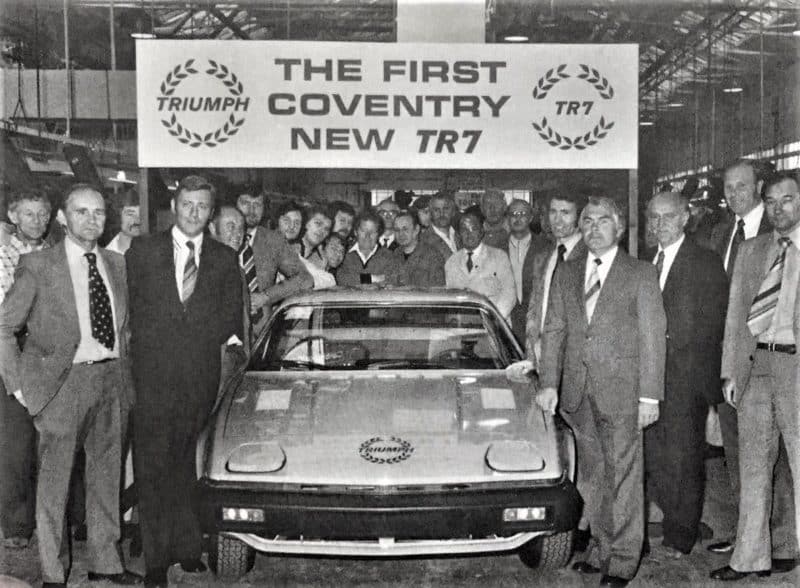

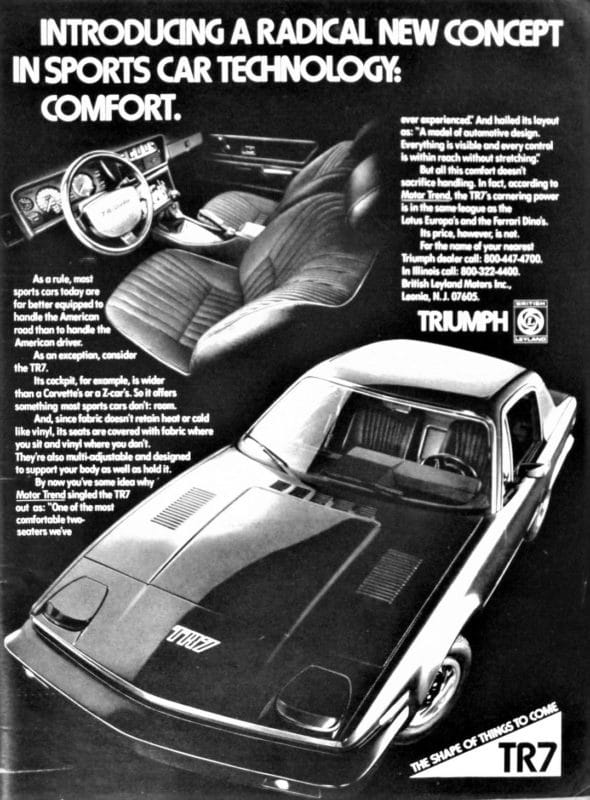

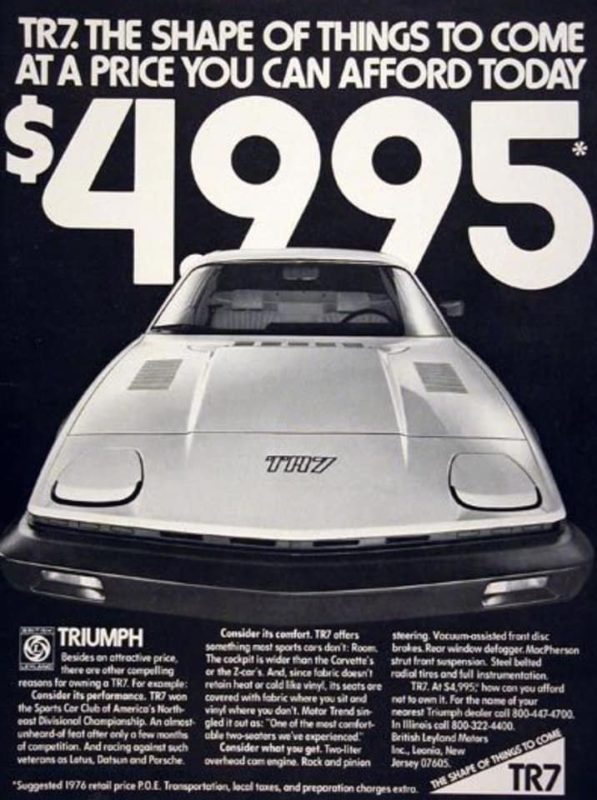


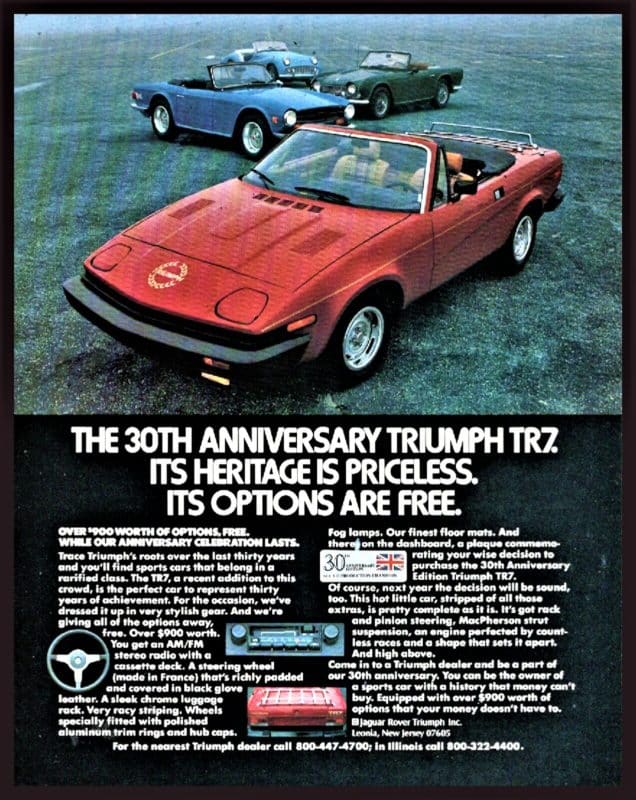
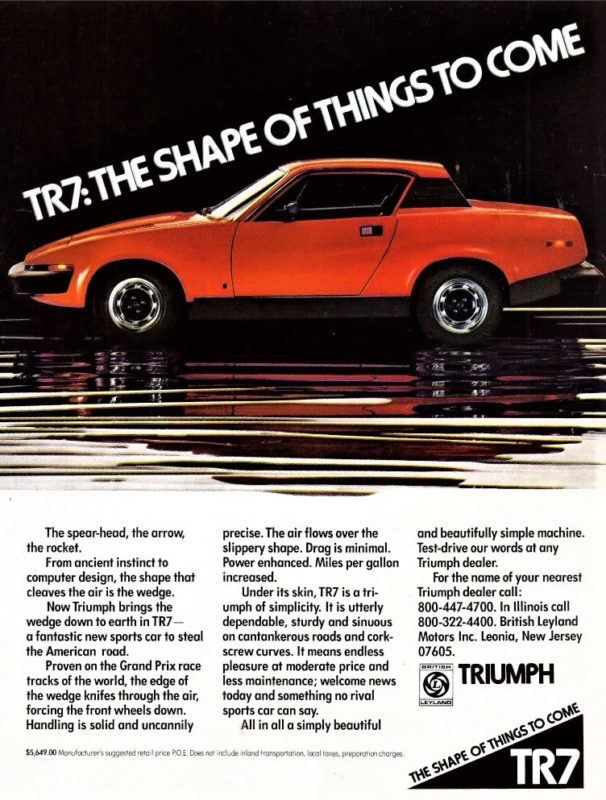



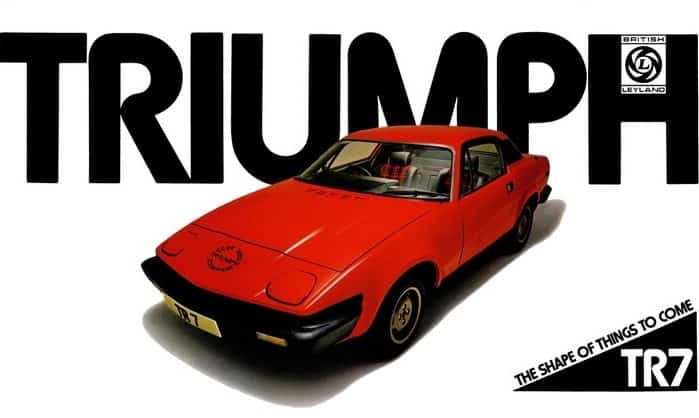



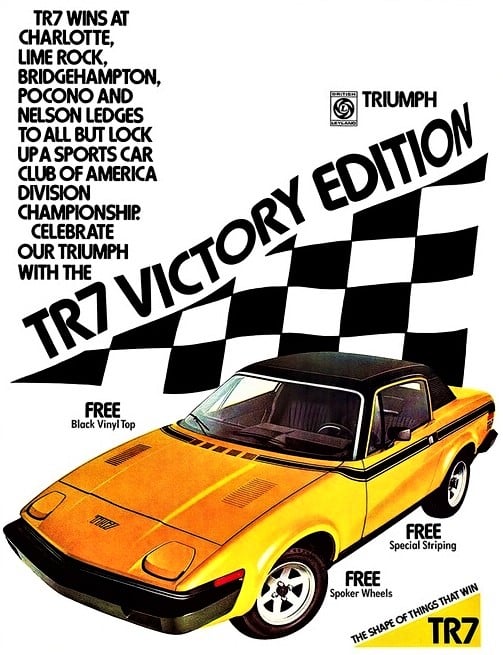
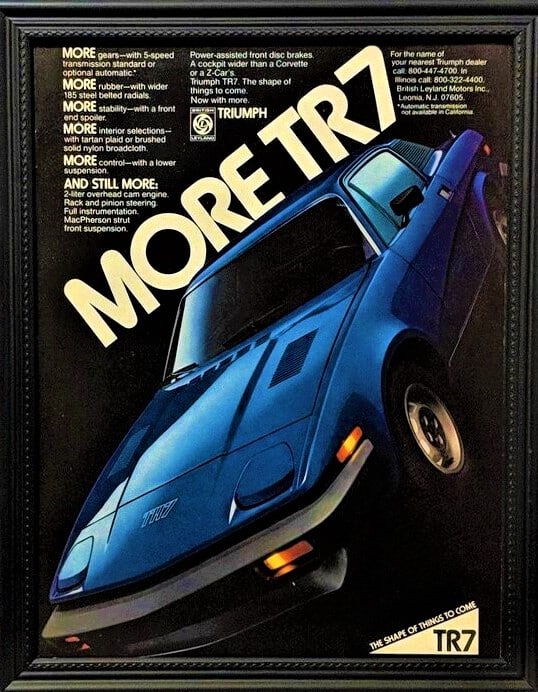
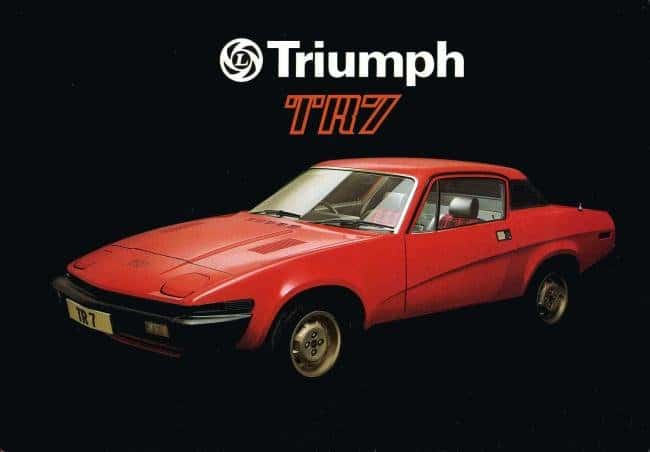



The only thing that was really good about it was the engine,
from GM…..
every time I pick up the TR 8 convertible, the sound is great, due to its split exhaust system, have it loud performance.
Nice car. The TVR Tasmin of that time had a similar 'wedge design'.
I still think it's a great car, and the reliability was fine.
I've had 3 myself, they've never let me down, they were just my daily drivers.
I started with a 1979 coupe built in Canley, which had the Rover 5-speed gearbox and the red checkered upholstery as standard, then I had a 1981 coupe built in Solihul, which had a very nice begie interior and these models had the Webasto folding roof as standard.
And finally in 1990 I bought a tr8 bj 1980 this convertible was really the ultimate triumph with the wonderful 3.5 liter V 8 with injection at that time there were only 4 of them in nl, please note this was an original factory tr8, and I still have a warm heart for the tr7
Brrr, I sometimes dream of such a thing when I've had a heavy dinner…
Having to mess around in some lost evening hours a little too much for someone else….
It was an ideal car to increase your circle of friends. Already after 1 winter, you knew
the names of most tow truck drivers.
It was here in BC, a drama on wheels. Never mind the design. TR-6 is still
increasingly popular, you see a few every day in the wild, stay beautiful and sound good.
Greetings from a very warm YVR.
and your death did not want to be seen in that, what a monstrosity.
still.
In recent years there has been growing interest in the WEDGE in the USA and the UK, the rarest type being the TR8 pre-production coupe, with 150 cars produced, it is truly a collector's item. Marketed to meet the homologation requirements to participate in the WRC rally. Successes were achieved here by Tony Pond and Fred Galllenger. Of the 150 produced cars, there are still about 40 left today, 2 of which are in the Netherlands.